12 Fish for Beginners
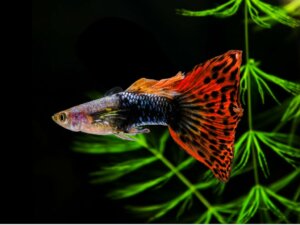

Written and verified by the biologist Samuel Sanchez
Have you ever thought about having an aquarium? Freshwater tanks bring tranquility and knowledge in equal parts to the home. Observing the fish creating a true ecosystem is a pleasure, but you also learn a lot about the dynamics of the different bodies of water by controlling their chemical parameters. Learn about the ideal fish for beginners in today’s article.
Maintaining an aquarium can be either very simple or a very difficult task, depending on the species that you choose to keep, and the type of ecosystem that you want to imitate. In the following article, we’ll bring you 12 fish for beginners that are easy to care for. Don’t miss them!
1. Fish for beginners: The guppy (Poecilia reticulata)
The guppy is the quintessential freshwater fish and an ideal fish for beginners. The females are grayish-colored with striking colors on their tails and reach a length of 3 to 6 centimeters (1.2 to 2.2 inches). On the other hand, males barely reach 3.5 centimeters as a maximum length, but they have some of the most beautiful tails in the entire animal kingdom.
Their life expectancy is 2 years and they’re very peaceful animals, and can mix without any problem with other freshwater species that share their environmental requirements. The tank must have a capacity of at least 40 liters, but remember that each specimen you add will increase the demand of the tank by 5 more liters.
- Temperature: From 20 to 28 ºC (68 to 82 Fahrenheit), but the ideal water temperature is 25 ºC.
- pH: between 7.0 and 8.0.
- Aquarium size: A minimum of 40 liters (8.8 gallons) for about 5 specimens. If 150 liters (33 gallons) are available for a larger group, the better.
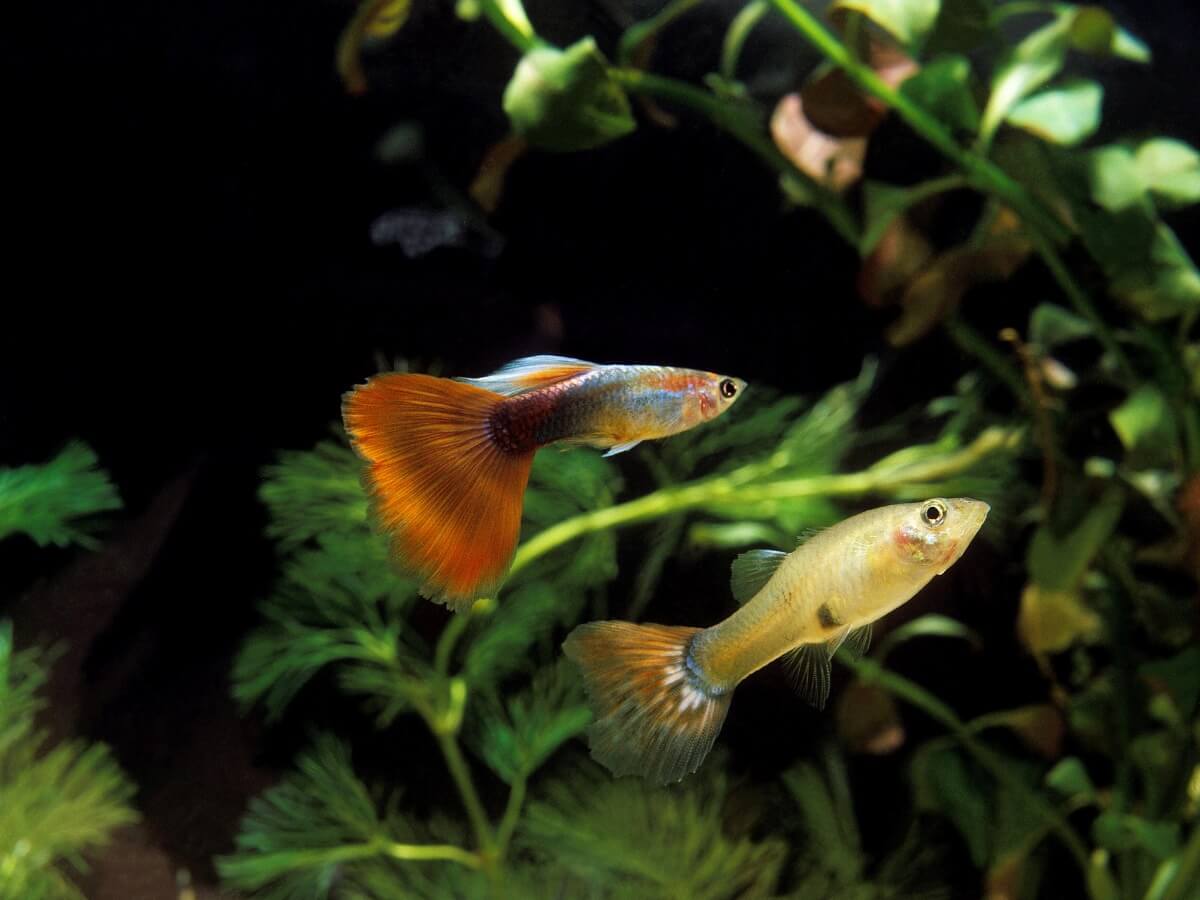
2. Molly (Poecilia sphenops)
These fish belong to the same genus as guppies, but are somewhat larger and more voluminous. Males grow up to 6 centimeters (2.2 inches) in length, while females can grow up to 10 centimeters (4 inches). Their sexual dimorphism doesn’t end here, as the males are much slimmer, have larger fins, and have a gonopod — which is used for mating.
- Temperature: These fish endure a relatively wide range, but ideally the water should be between 24 and 26.7 ° C (75 to 80 F).
- pH: between 6.7 and 8.5.
- Aquarium size: A minimum of 40 liters. They can live perfectly well with guppies and other freshwater fish, but the aquarium must have plants and appear as natural as possible.
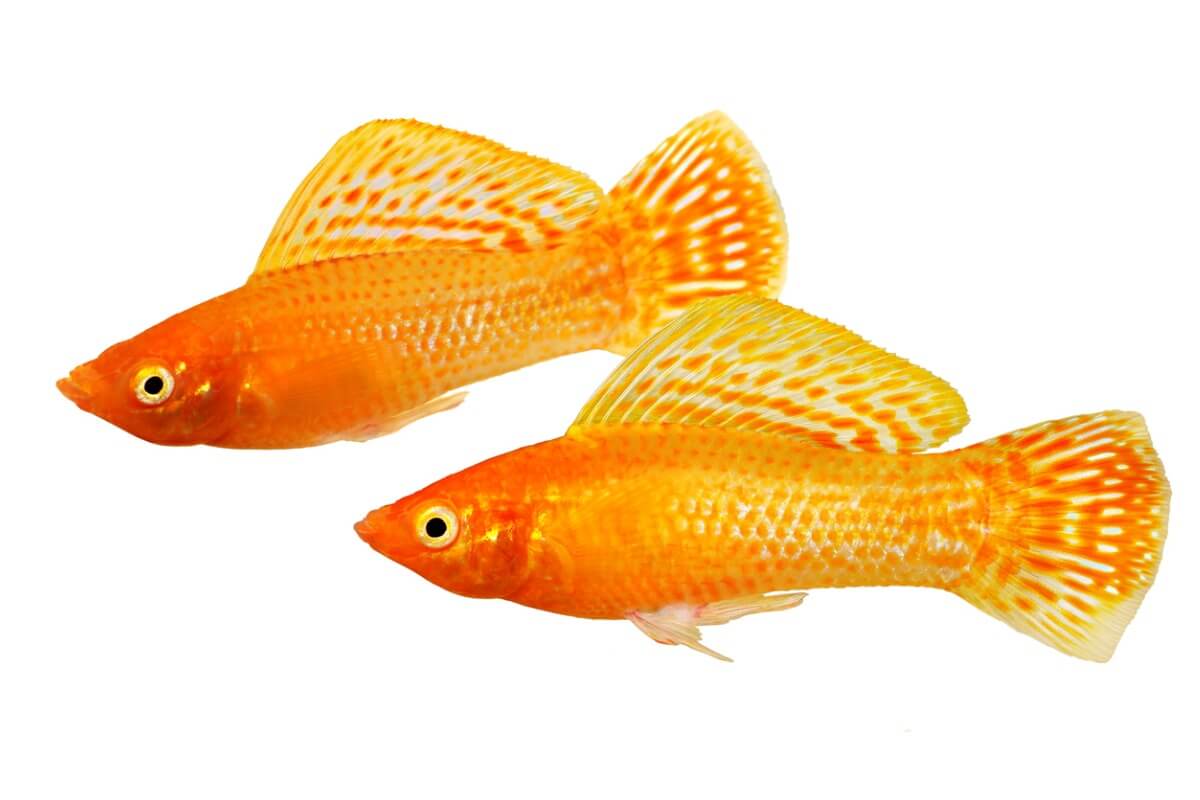
3. Zebrafish (Danio rerio)
This animal is another ideal fish for beginners, as it has a dazzling appearance with minimal requirements. It’s a small fish, 1.8 to 3.7 centimeters long (less than an inch to an inch and a half), which stands out, above all, for its five prominent bluish stripes that run horizontally across its body.
The only complication of this species is that they’re fish that live in shoals. Therefore, not all typical zebrafish behavior patterns can be detected unless you have a large number of specimens in the aquarium. As a general rule, a minimum of five zebrafish should be introduced into the aquarium so that they don’tt become depressed and die.
- Temperature: The ideal water temperature is between 17 and 24 °C (62 to 75 Fahrenheit), but this fish can adapt to much warmer waters.
- pH: Between 6.0 and 8.0.
- Aquarium size: A small group can cope with a 20-liter (4.4 gallon) aquarium for a time, but this isn’t ideal. With a capacity of 100 liters (22 gallons) or more, you can have a school of more than 10 specimens.
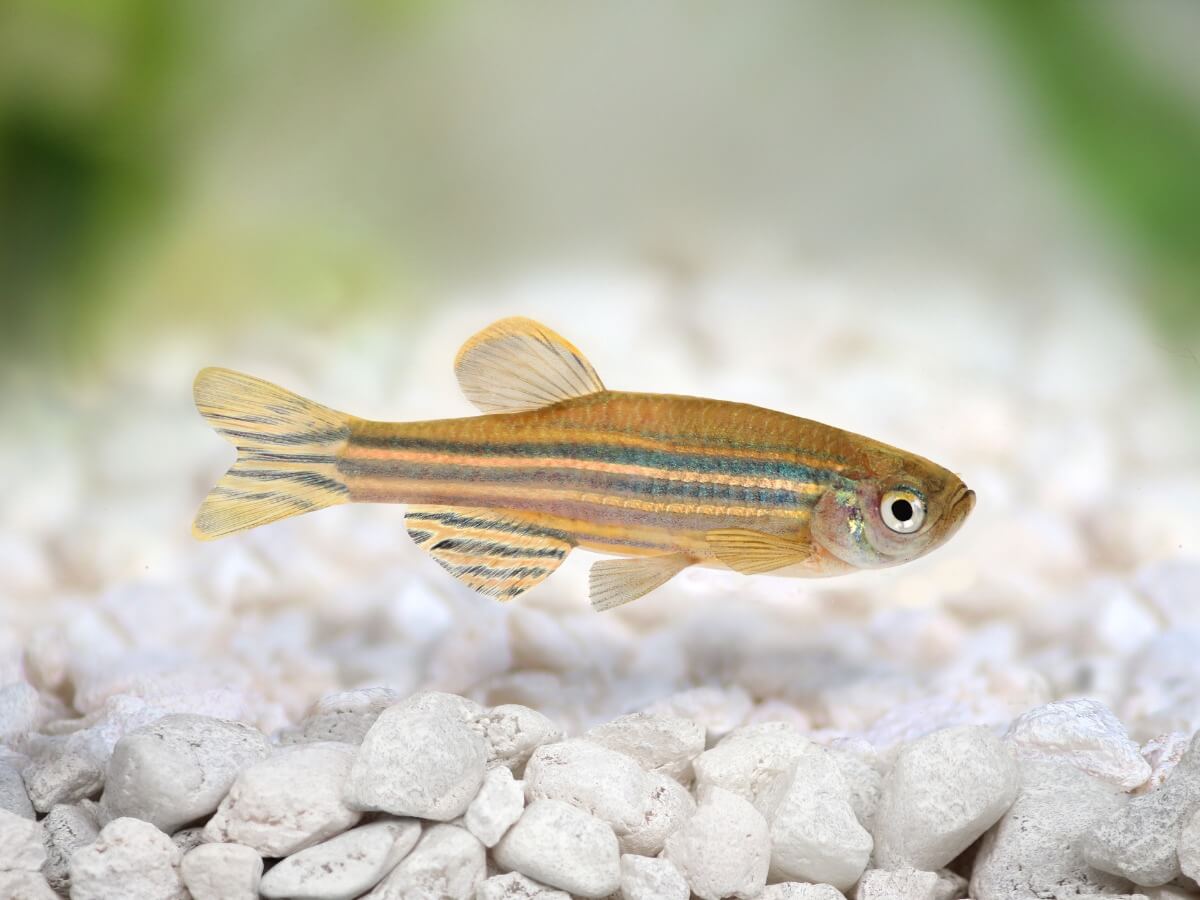
4. Betta fish (Betta splendens)
The betta fish is another of the most suitable fish for beginners, but the idea that people have about this species is very wrong. These animals can’t live in tiny fish tanks, just as they can’t do well in a facility that doesn’t have a heater or filtering system. They’re very resistant animals, but not invincible.
In addition, it must be taken into account that these fish are extremely aggressive and territorial. Two males together will kill each other instantly and the males constantly harass the females. For this reason, it’s never conceivable to keep more than one specimen of the same species in the aquarium.
- Temperature: The ideal temperature is 26 ºC (79 F). Values below 22 ºC (71 F) can endanger the life of the fish.
- pH: Between 4.0 and 7.0. Bettas are extremely hardy, due to their ability to survive in waters with highly variable pH and hardness.
- Aquarium: 20 liters (4.4 gallons) per specimen. It shouldn’t be mixed with other fish in any case, unless they’re live on the bottom of the tank.

5. Common pleco (Hypostomus plecostomus)
The common pleco (also known as the suckermouth catfish) is a bottom feeder fish par excellence and a good natural cleaner, as it feeds on the algae that populate the aquarium. It’s a very resistant species that sporadically feeds on plant matter, waste, and crustaceans. Contrary to what many people think, you have to feed them specific pills, as algae are only part of their diet. Simply let them drop to the bottom of the tank.
The only complication of this fish for beginners is the size it reaches. An adult specimen easily reaches 30 centimeters (12 inches) in length, so it only has to be placed in large-capacity aquariums or ponds.
- Temperature: From 22 to 30 °C.
- pH: Between 6.5 and 7.5.
- Aquarium size: These fish should be kept in aquariums of 500 liters (110 gallons) and upwards. They’re ideal for tanks with very large species and for ponds.
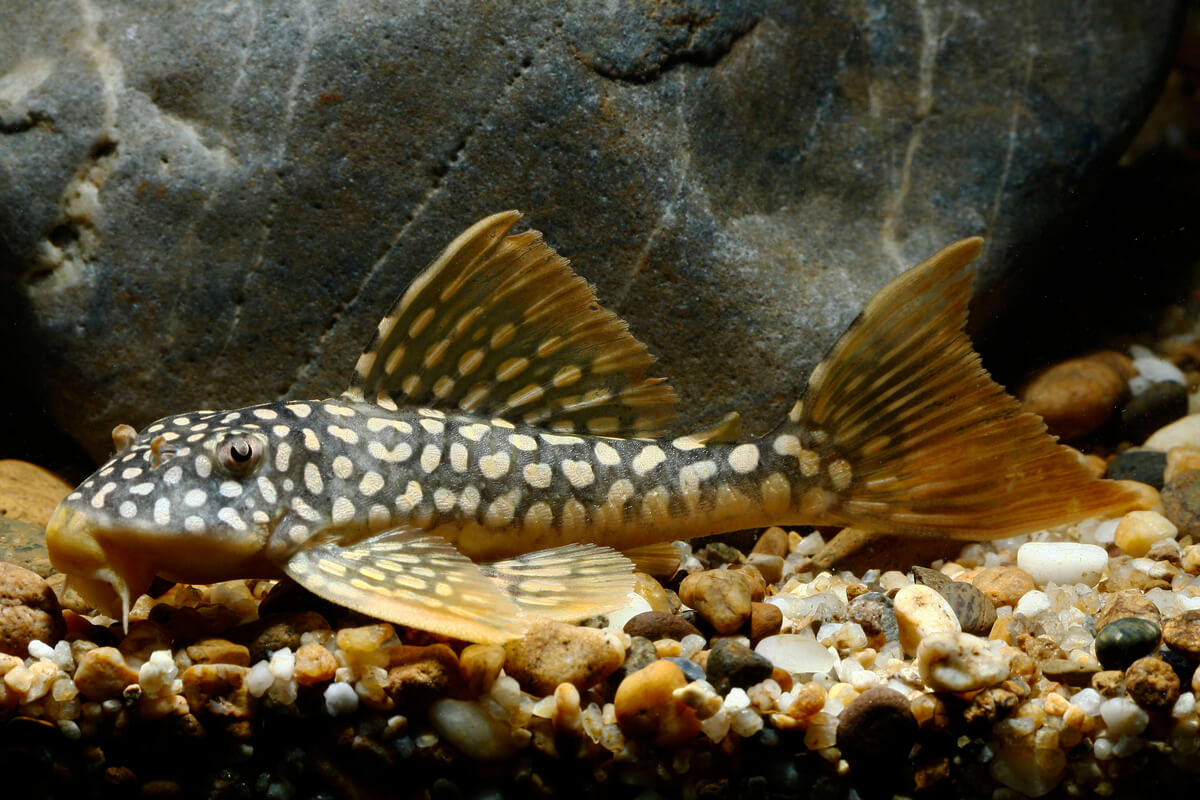
6. Oscar fish (Astronotus ocellatus)
Without a doubt, this is one of the most impressive, beautiful, and resistant freshwater fish in the world. The oscar fish will make every owner fall in love with them with its behavior, characteristics, and its orange-blackish colors, but its size can be a very big drawback. Keep in mind that some specimens reach 50 centimeters (20 inches) in length and 1.6 kilograms in weight (3.5 pounds).
These aggressive and territorial fish can live up to 20 years with proper care. In addition, they tend to live without having too many problems with other passive fish of considerable size. On the contrary, every small companion in the tank will become their snack.
- Temperature: Between 23 and 27 ºC (73 to 80 F). However, specimens have been found in much colder waters.
- pH: Between 6.0 and 8.0, with an ideal value of 7.2.
- Aquarium size: A minimum of 200 liters (44 gallons), although the ideal capacity is 250-280 liters (55 to 62 gallons) for a single oscar fish. These fish can be kept in groups, but, due to their territoriality, the size of the tank must be increased astronomically when more than two specimens are brought together.
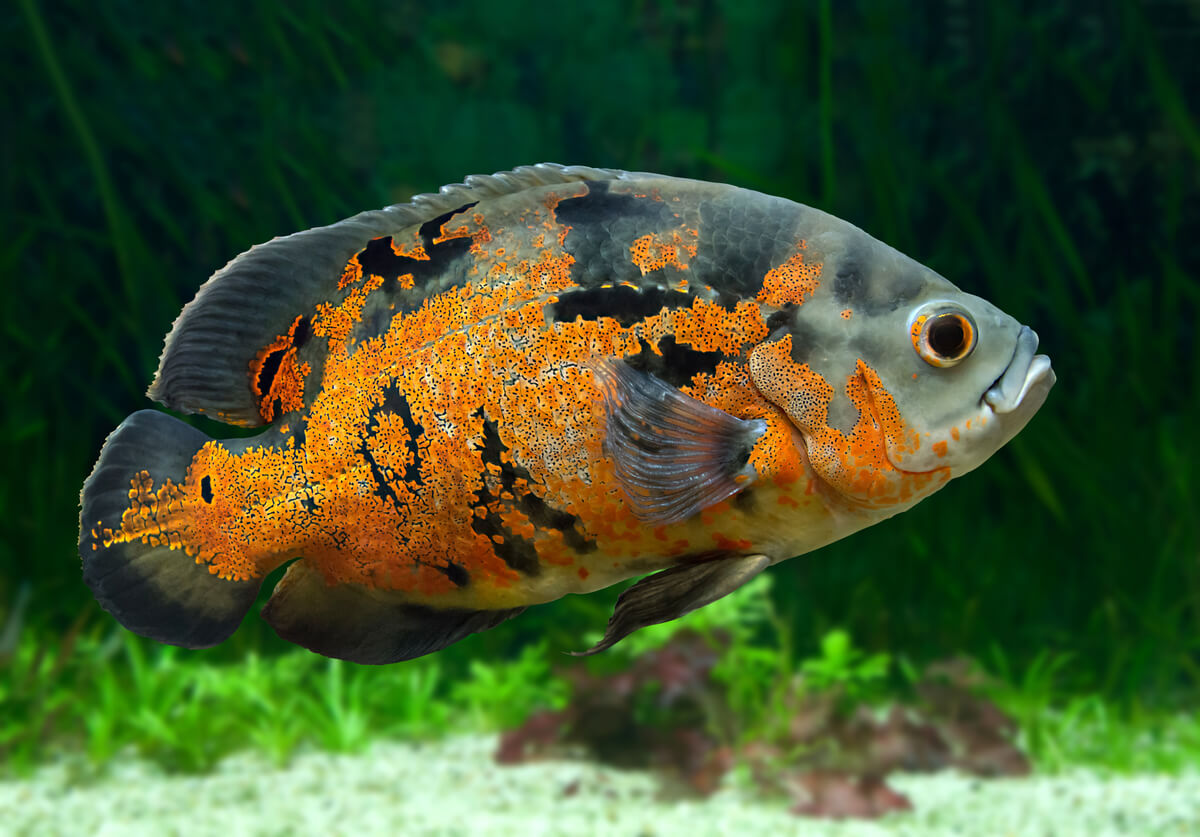
7. Neon tetra (Paracheirodon innesi)
The neon tetra is another of the ideal fish for beginners. It’s very small size and suitable for small aquariums. Its body is fusiform and has an average length of 1.5 centimeters (just over half an inch), but it stands out for its semitransparent color and its striking phosphorous bluish-reddish tones.
Like the danios (zebrafish), these fish live in shoals and their behavioral display is much clearer when several specimens are kept in the aquarium. A minimum of six fish per tank should be introduced, but the ideal size of a community is 12 species or more.
- Temperature: Between 20 and 28 °C (68 to 82 F), but the ideal water temperature is an average of 24 °C.
- pH: Between 4.0 and 7.5. They’re very resistant fish to environmental variations.
- Aquarium size: For a small group a 30-40 liter (6.6 to 8.8 gallons) aquarium can be ideal. However, an ideal community of 15 individuals would need an 80-liter (17.6-gallon) tank.
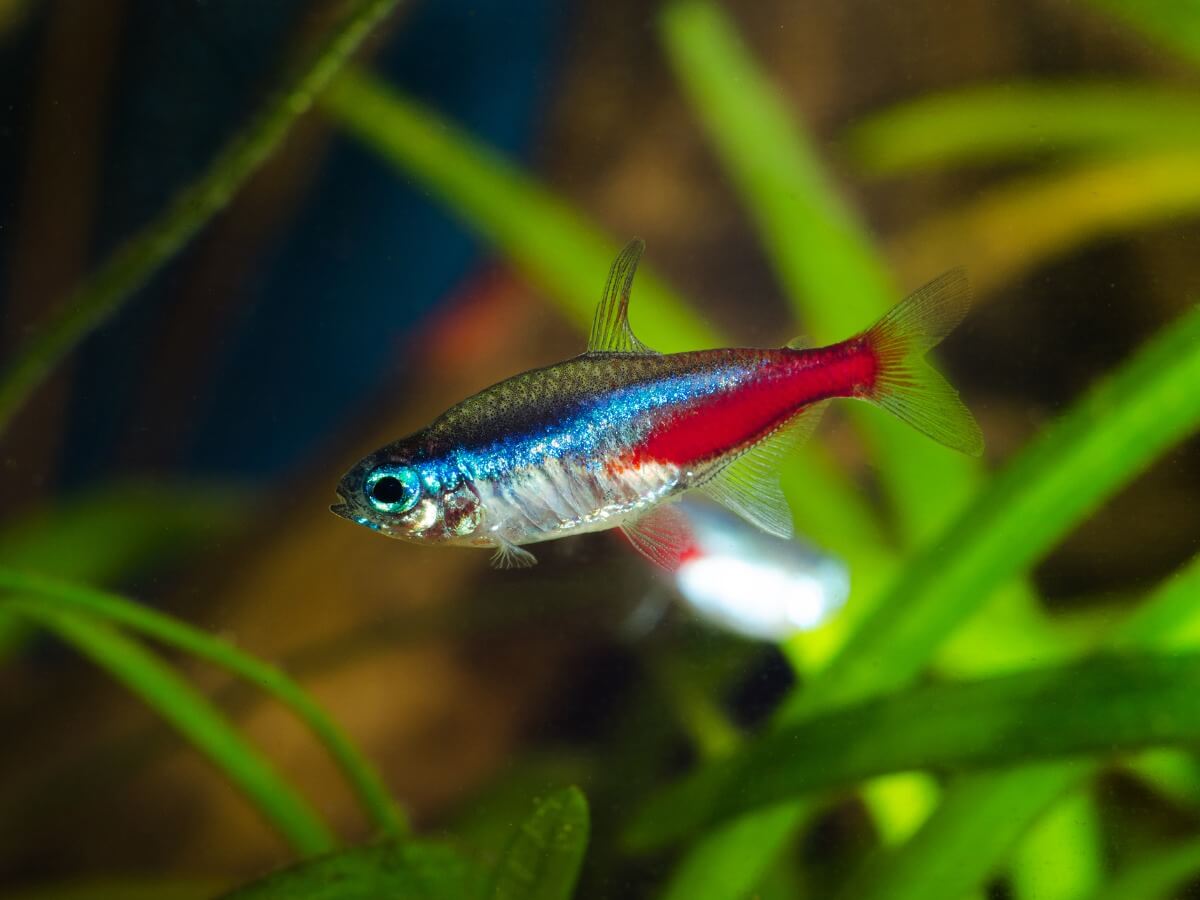
8. Corydoras genus
The Corydoras genus encompasses some of the most effective and easy-to-maintain aquarium cleaners. They live in groups of 4 to 5 specimens, most of which stay quite small – between 3 and 12 centimeters (1.2 to 5 inches) – and clean the aquarium bottoms very efficiently. They are very resistant fish, but you have to be careful not to place them in fish tanks with pointed substrates.
- Temperature: 26 ºC (79 F) ideally, although some species can withstand much lower temperatures.
- pH: Ideally between 7.0 and 8.0.
- Aquarium size: A 40-liter (8.8 gallon) aquarium can hold 2 or 3 specimens, but they live much better in large tanks. Remember that they prefer sandy and fine substrates, as it allows them to dig for food.
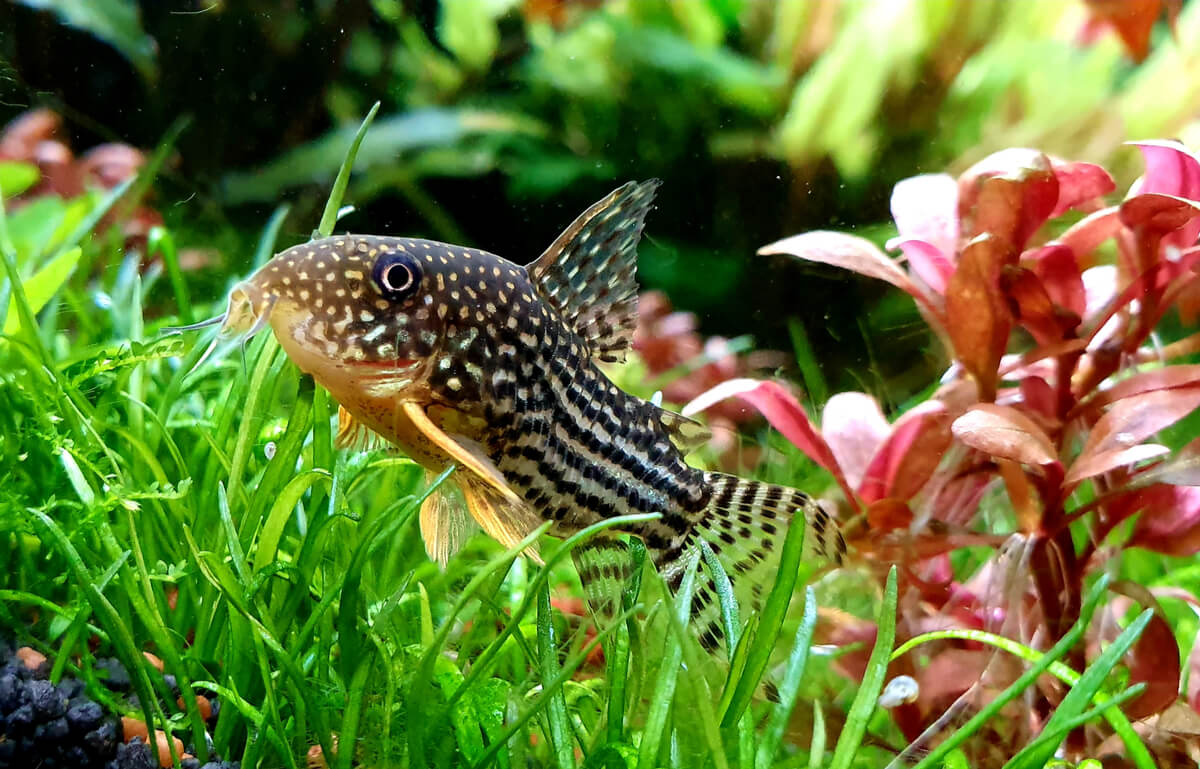
9. Harlequin Rasbora (Trigonostigma heteromorpha)
The harlequin rasbora is the most famous representative of the genus Rasbora and one of the most suitable fish for beginners. It’s a small species with muted copper tones, but it has a triangular patch that runs from the middle of the back to the tail, which makes it very characteristic. They’re shoal animals, so there should be at least 5 specimens in the tank together.
- Temperature: From 24 to 27 ºC (75 to 80 F).
- pH: Between 6.8 and 7.8.
- Aquarium size: As is customary in this list, a minimum volume of 40 liters (8.8 gallons) is recommended for a small group of harlequin rasboras.

10. Goldfish (Carassius auratus)
The goldfish is one of the beginner fish par excellence, and it’s often sold in pet stores. The specimens don’t grow according to the size of the aquarium nor can they live in a glass bowl. They’re hardy animals, but, like bettas, they require a minimum to survive.
This species reaches a significant size, as an adult fish easily reaches 15 centimeters (6 inches) in a glass aquarium and up to 40 centimeters (16 inches) in a tank, depending on the variety. They produce a lot of droppings at a very fast rate, so a community of goldfish requires a very powerful filter in the tank.
- Temperature: Between 20 and 24 ºC (68 to 75 F), although this species withstands much lower temperatures without getting sick. Therefore, they’re the only fish on the entire list that can be considered cold water fish.
- pH: Between 6.8 and 7.8.
- Aquarium size: each goldfish needs a minimum of 40 liters (8.8 gallons) to live and another 40 liters must be added for each more specimen in the tank. A group of 3 fish will therefore need about 120 liters (26 gallons) of water.
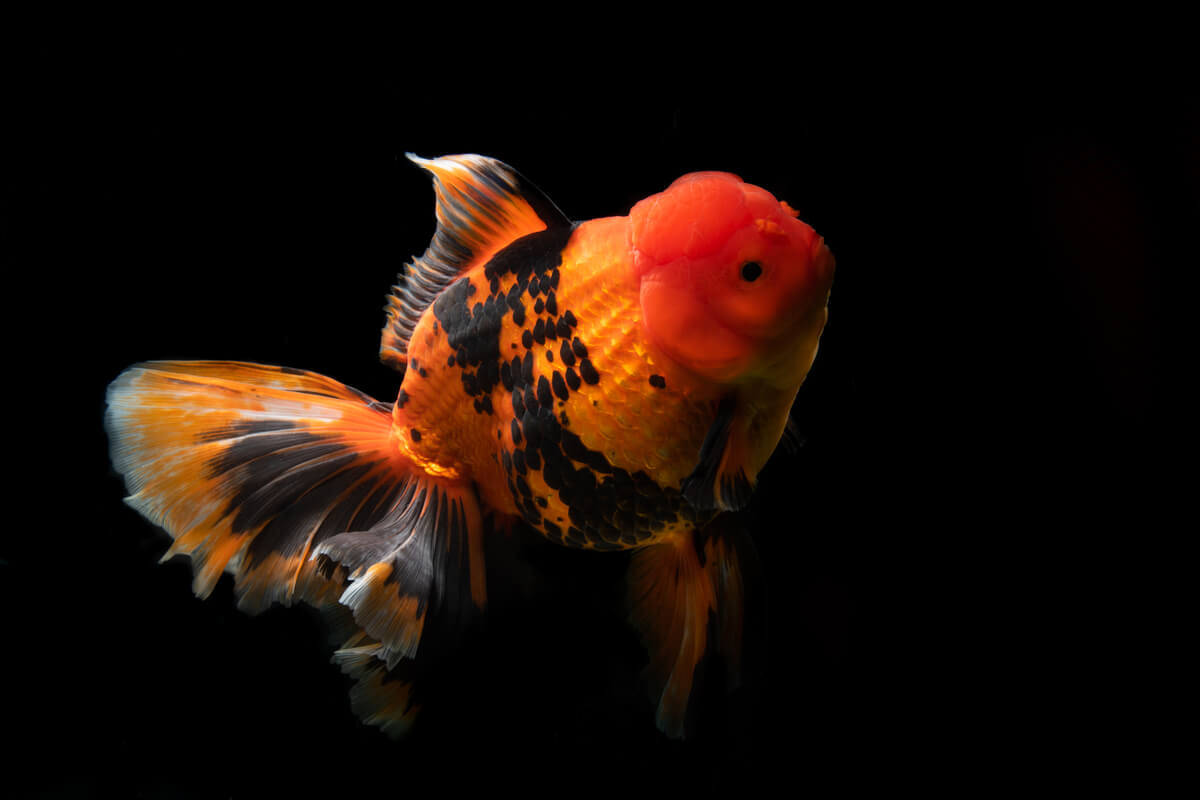
11. Tiger barbel (Puntius tetrazona)
This is another species that lives in groups, but, in this case, it’s slightly larger than that of other members of this list. The tiger barbel can reach 7.5 centimeters (3 inches) in length in its natural environment, but, in captivity, it doesn’t usually exceed 5 centimeters (2 inches). It stands out for its yellow background color and the horizontal stripes that run through its body.
As shoal fish that they are, they should be kept in groups of at least 6 members. In any case, as is the case with other species already mentioned, the ideal thing is to put about 12 specimens together in the tank.
- Temperature: Between 25 and 28 ºC (77 to 82 F) is ideal.
- pH: Between 6.0 and 8.0.
- Aquarium size: Being larger fish than neons or harlequins, they need more water in the tank. A group of 5 can be kept in an 80-liter (17.6 gallons) tank, but the ideal thing is to increase the size of the aquarium to 150 liters (33 gallons) and keep a community of 12 specimens.
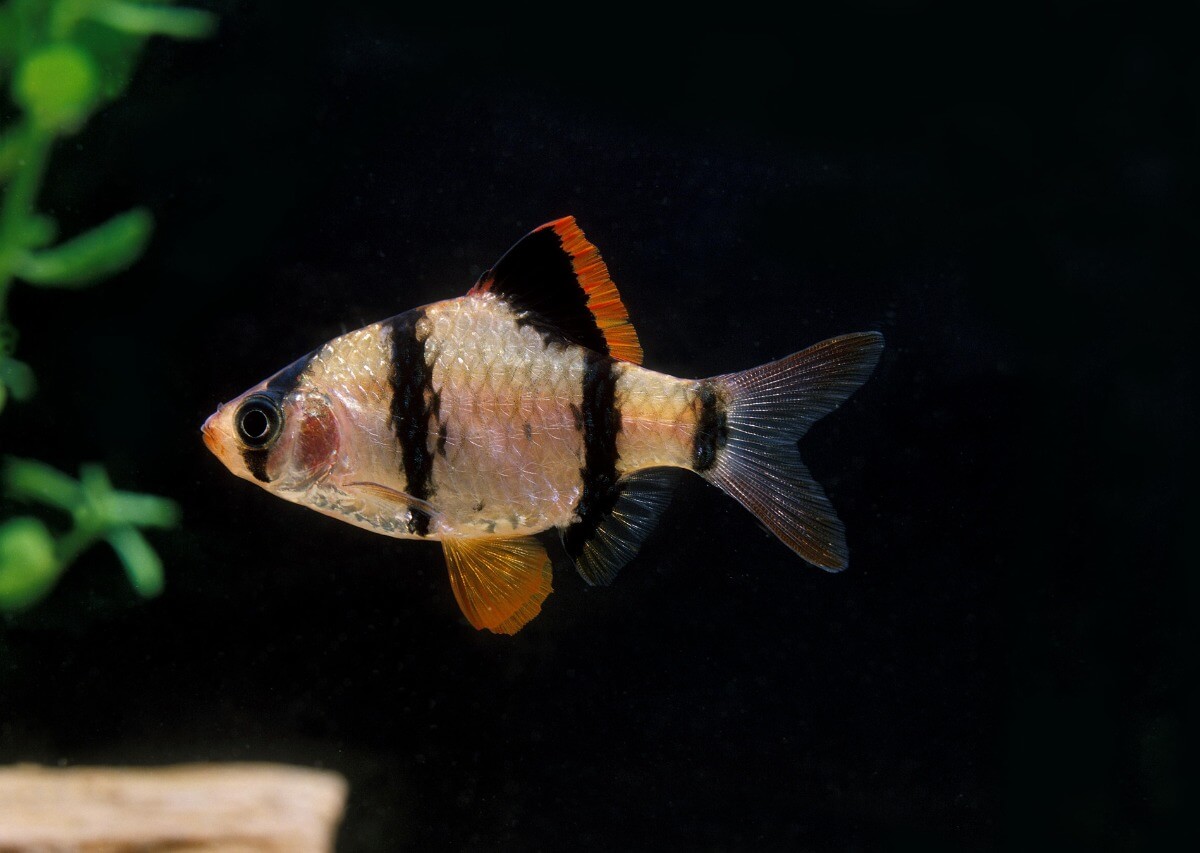
12. Green swordtail (Xiphophorus hellerii)
We close this article with a species similar to a molly, but with some special characteristics. These fish for beginners are medium in size, with the males reaching about 14 centimeters (nearly 6 inches) in total length and the females 16 centimeters (just over 6 inches). The sexual dimorphism is very evident, as the males have a very long tip on their tail fin.
- Temperature: They cope well with a range of between 22 and 28 ºC (71 to 82 F), although it’s best to maintain an average temperature of about 25 ºC (77 F).
- pH: Between 7.0 and 8.4.
- Aquarium size: For a couple of fish, an aquarium with a minimum capacity of 40 liters (8.8 gallons) is required. However, these fish live well with other species and can be housed in large community tanks.
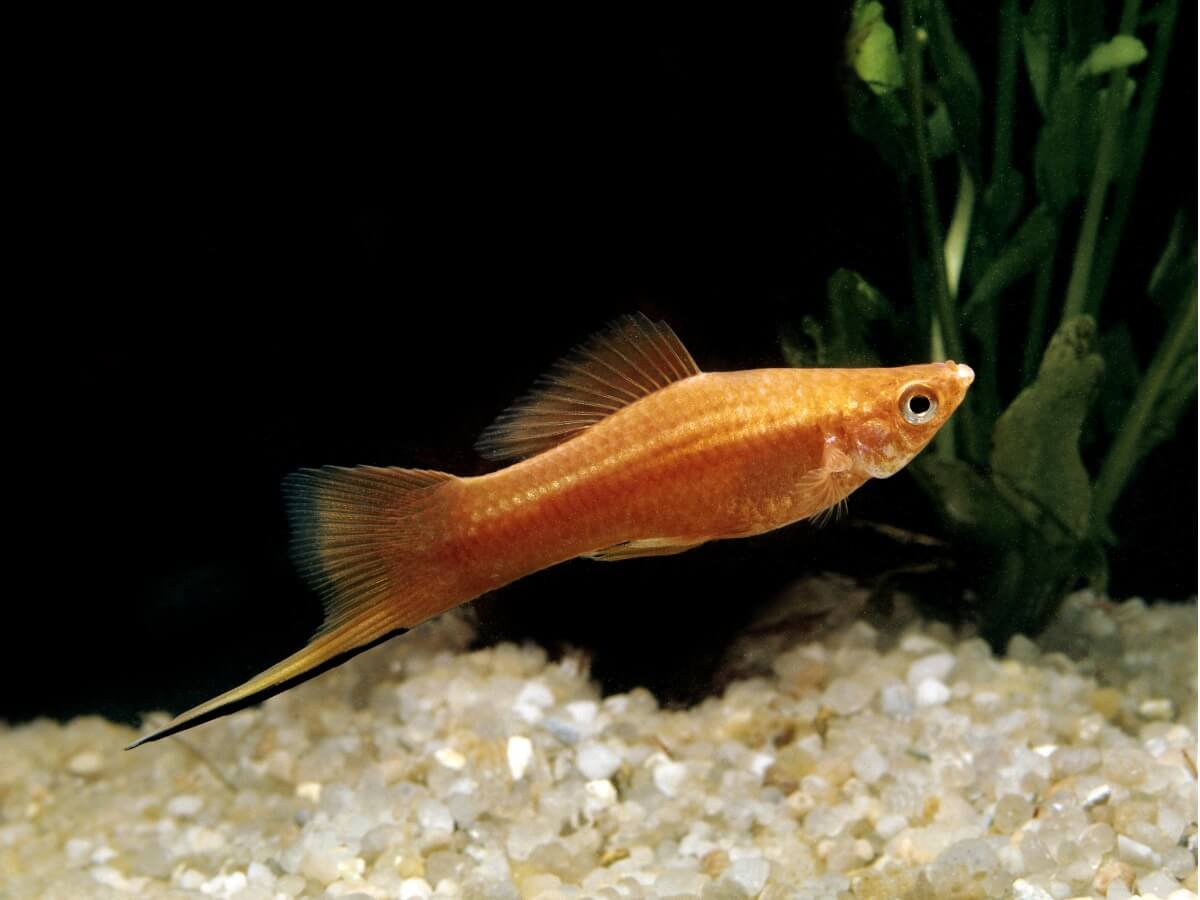
Final notes
What do you think of these beginner-friendly fish? As you can see, most have similar requirements: an aquarium of at least 40 liters (8.8 gallons), tropical temperatures, and a standard pH. Some of the fish cited here can be kept together, but others require their own space and very special considerations.
For example, the oscar fish and the common pleco can become very large, while the betta fish are very small but aggressive and territorial. Each species has its peculiarities, so if you have any questions, don’t worry – ask the experts!
Have you ever thought about having an aquarium? Freshwater tanks bring tranquility and knowledge in equal parts to the home. Observing the fish creating a true ecosystem is a pleasure, but you also learn a lot about the dynamics of the different bodies of water by controlling their chemical parameters. Learn about the ideal fish for beginners in today’s article.
Maintaining an aquarium can be either very simple or a very difficult task, depending on the species that you choose to keep, and the type of ecosystem that you want to imitate. In the following article, we’ll bring you 12 fish for beginners that are easy to care for. Don’t miss them!
1. Fish for beginners: The guppy (Poecilia reticulata)
The guppy is the quintessential freshwater fish and an ideal fish for beginners. The females are grayish-colored with striking colors on their tails and reach a length of 3 to 6 centimeters (1.2 to 2.2 inches). On the other hand, males barely reach 3.5 centimeters as a maximum length, but they have some of the most beautiful tails in the entire animal kingdom.
Their life expectancy is 2 years and they’re very peaceful animals, and can mix without any problem with other freshwater species that share their environmental requirements. The tank must have a capacity of at least 40 liters, but remember that each specimen you add will increase the demand of the tank by 5 more liters.
- Temperature: From 20 to 28 ºC (68 to 82 Fahrenheit), but the ideal water temperature is 25 ºC.
- pH: between 7.0 and 8.0.
- Aquarium size: A minimum of 40 liters (8.8 gallons) for about 5 specimens. If 150 liters (33 gallons) are available for a larger group, the better.

2. Molly (Poecilia sphenops)
These fish belong to the same genus as guppies, but are somewhat larger and more voluminous. Males grow up to 6 centimeters (2.2 inches) in length, while females can grow up to 10 centimeters (4 inches). Their sexual dimorphism doesn’t end here, as the males are much slimmer, have larger fins, and have a gonopod — which is used for mating.
- Temperature: These fish endure a relatively wide range, but ideally the water should be between 24 and 26.7 ° C (75 to 80 F).
- pH: between 6.7 and 8.5.
- Aquarium size: A minimum of 40 liters. They can live perfectly well with guppies and other freshwater fish, but the aquarium must have plants and appear as natural as possible.

3. Zebrafish (Danio rerio)
This animal is another ideal fish for beginners, as it has a dazzling appearance with minimal requirements. It’s a small fish, 1.8 to 3.7 centimeters long (less than an inch to an inch and a half), which stands out, above all, for its five prominent bluish stripes that run horizontally across its body.
The only complication of this species is that they’re fish that live in shoals. Therefore, not all typical zebrafish behavior patterns can be detected unless you have a large number of specimens in the aquarium. As a general rule, a minimum of five zebrafish should be introduced into the aquarium so that they don’tt become depressed and die.
- Temperature: The ideal water temperature is between 17 and 24 °C (62 to 75 Fahrenheit), but this fish can adapt to much warmer waters.
- pH: Between 6.0 and 8.0.
- Aquarium size: A small group can cope with a 20-liter (4.4 gallon) aquarium for a time, but this isn’t ideal. With a capacity of 100 liters (22 gallons) or more, you can have a school of more than 10 specimens.

4. Betta fish (Betta splendens)
The betta fish is another of the most suitable fish for beginners, but the idea that people have about this species is very wrong. These animals can’t live in tiny fish tanks, just as they can’t do well in a facility that doesn’t have a heater or filtering system. They’re very resistant animals, but not invincible.
In addition, it must be taken into account that these fish are extremely aggressive and territorial. Two males together will kill each other instantly and the males constantly harass the females. For this reason, it’s never conceivable to keep more than one specimen of the same species in the aquarium.
- Temperature: The ideal temperature is 26 ºC (79 F). Values below 22 ºC (71 F) can endanger the life of the fish.
- pH: Between 4.0 and 7.0. Bettas are extremely hardy, due to their ability to survive in waters with highly variable pH and hardness.
- Aquarium: 20 liters (4.4 gallons) per specimen. It shouldn’t be mixed with other fish in any case, unless they’re live on the bottom of the tank.

5. Common pleco (Hypostomus plecostomus)
The common pleco (also known as the suckermouth catfish) is a bottom feeder fish par excellence and a good natural cleaner, as it feeds on the algae that populate the aquarium. It’s a very resistant species that sporadically feeds on plant matter, waste, and crustaceans. Contrary to what many people think, you have to feed them specific pills, as algae are only part of their diet. Simply let them drop to the bottom of the tank.
The only complication of this fish for beginners is the size it reaches. An adult specimen easily reaches 30 centimeters (12 inches) in length, so it only has to be placed in large-capacity aquariums or ponds.
- Temperature: From 22 to 30 °C.
- pH: Between 6.5 and 7.5.
- Aquarium size: These fish should be kept in aquariums of 500 liters (110 gallons) and upwards. They’re ideal for tanks with very large species and for ponds.

6. Oscar fish (Astronotus ocellatus)
Without a doubt, this is one of the most impressive, beautiful, and resistant freshwater fish in the world. The oscar fish will make every owner fall in love with them with its behavior, characteristics, and its orange-blackish colors, but its size can be a very big drawback. Keep in mind that some specimens reach 50 centimeters (20 inches) in length and 1.6 kilograms in weight (3.5 pounds).
These aggressive and territorial fish can live up to 20 years with proper care. In addition, they tend to live without having too many problems with other passive fish of considerable size. On the contrary, every small companion in the tank will become their snack.
- Temperature: Between 23 and 27 ºC (73 to 80 F). However, specimens have been found in much colder waters.
- pH: Between 6.0 and 8.0, with an ideal value of 7.2.
- Aquarium size: A minimum of 200 liters (44 gallons), although the ideal capacity is 250-280 liters (55 to 62 gallons) for a single oscar fish. These fish can be kept in groups, but, due to their territoriality, the size of the tank must be increased astronomically when more than two specimens are brought together.

7. Neon tetra (Paracheirodon innesi)
The neon tetra is another of the ideal fish for beginners. It’s very small size and suitable for small aquariums. Its body is fusiform and has an average length of 1.5 centimeters (just over half an inch), but it stands out for its semitransparent color and its striking phosphorous bluish-reddish tones.
Like the danios (zebrafish), these fish live in shoals and their behavioral display is much clearer when several specimens are kept in the aquarium. A minimum of six fish per tank should be introduced, but the ideal size of a community is 12 species or more.
- Temperature: Between 20 and 28 °C (68 to 82 F), but the ideal water temperature is an average of 24 °C.
- pH: Between 4.0 and 7.5. They’re very resistant fish to environmental variations.
- Aquarium size: For a small group a 30-40 liter (6.6 to 8.8 gallons) aquarium can be ideal. However, an ideal community of 15 individuals would need an 80-liter (17.6-gallon) tank.

8. Corydoras genus
The Corydoras genus encompasses some of the most effective and easy-to-maintain aquarium cleaners. They live in groups of 4 to 5 specimens, most of which stay quite small – between 3 and 12 centimeters (1.2 to 5 inches) – and clean the aquarium bottoms very efficiently. They are very resistant fish, but you have to be careful not to place them in fish tanks with pointed substrates.
- Temperature: 26 ºC (79 F) ideally, although some species can withstand much lower temperatures.
- pH: Ideally between 7.0 and 8.0.
- Aquarium size: A 40-liter (8.8 gallon) aquarium can hold 2 or 3 specimens, but they live much better in large tanks. Remember that they prefer sandy and fine substrates, as it allows them to dig for food.

9. Harlequin Rasbora (Trigonostigma heteromorpha)
The harlequin rasbora is the most famous representative of the genus Rasbora and one of the most suitable fish for beginners. It’s a small species with muted copper tones, but it has a triangular patch that runs from the middle of the back to the tail, which makes it very characteristic. They’re shoal animals, so there should be at least 5 specimens in the tank together.
- Temperature: From 24 to 27 ºC (75 to 80 F).
- pH: Between 6.8 and 7.8.
- Aquarium size: As is customary in this list, a minimum volume of 40 liters (8.8 gallons) is recommended for a small group of harlequin rasboras.

10. Goldfish (Carassius auratus)
The goldfish is one of the beginner fish par excellence, and it’s often sold in pet stores. The specimens don’t grow according to the size of the aquarium nor can they live in a glass bowl. They’re hardy animals, but, like bettas, they require a minimum to survive.
This species reaches a significant size, as an adult fish easily reaches 15 centimeters (6 inches) in a glass aquarium and up to 40 centimeters (16 inches) in a tank, depending on the variety. They produce a lot of droppings at a very fast rate, so a community of goldfish requires a very powerful filter in the tank.
- Temperature: Between 20 and 24 ºC (68 to 75 F), although this species withstands much lower temperatures without getting sick. Therefore, they’re the only fish on the entire list that can be considered cold water fish.
- pH: Between 6.8 and 7.8.
- Aquarium size: each goldfish needs a minimum of 40 liters (8.8 gallons) to live and another 40 liters must be added for each more specimen in the tank. A group of 3 fish will therefore need about 120 liters (26 gallons) of water.

11. Tiger barbel (Puntius tetrazona)
This is another species that lives in groups, but, in this case, it’s slightly larger than that of other members of this list. The tiger barbel can reach 7.5 centimeters (3 inches) in length in its natural environment, but, in captivity, it doesn’t usually exceed 5 centimeters (2 inches). It stands out for its yellow background color and the horizontal stripes that run through its body.
As shoal fish that they are, they should be kept in groups of at least 6 members. In any case, as is the case with other species already mentioned, the ideal thing is to put about 12 specimens together in the tank.
- Temperature: Between 25 and 28 ºC (77 to 82 F) is ideal.
- pH: Between 6.0 and 8.0.
- Aquarium size: Being larger fish than neons or harlequins, they need more water in the tank. A group of 5 can be kept in an 80-liter (17.6 gallons) tank, but the ideal thing is to increase the size of the aquarium to 150 liters (33 gallons) and keep a community of 12 specimens.

12. Green swordtail (Xiphophorus hellerii)
We close this article with a species similar to a molly, but with some special characteristics. These fish for beginners are medium in size, with the males reaching about 14 centimeters (nearly 6 inches) in total length and the females 16 centimeters (just over 6 inches). The sexual dimorphism is very evident, as the males have a very long tip on their tail fin.
- Temperature: They cope well with a range of between 22 and 28 ºC (71 to 82 F), although it’s best to maintain an average temperature of about 25 ºC (77 F).
- pH: Between 7.0 and 8.4.
- Aquarium size: For a couple of fish, an aquarium with a minimum capacity of 40 liters (8.8 gallons) is required. However, these fish live well with other species and can be housed in large community tanks.

Final notes
What do you think of these beginner-friendly fish? As you can see, most have similar requirements: an aquarium of at least 40 liters (8.8 gallons), tropical temperatures, and a standard pH. Some of the fish cited here can be kept together, but others require their own space and very special considerations.
For example, the oscar fish and the common pleco can become very large, while the betta fish are very small but aggressive and territorial. Each species has its peculiarities, so if you have any questions, don’t worry – ask the experts!
All cited sources were thoroughly reviewed by our team to ensure their quality, reliability, currency, and validity. The bibliography of this article was considered reliable and of academic or scientific accuracy.
- Kalueff, A. V., Gebhardt, M., Stewart, A. M., Cachat, J. M., Brimmer, M., Chawla, J. S., … & Schneider, and the Zebrafish Neuroscience Research Consortium, H. (2013). Towards a comprehensive catalog of zebrafish behavior 1.0 and beyond. Zebrafish, 10(1), 70-86.
- Nanda, I., Feichtinger, W., Schmid, M., Schröder, J. H., Zischler, H., & Epplen, J. T. (1990). Simple repetitive sequences are associated with differentiation of the sex chromosomes in the guppy fish. Journal of Molecular Evolution, 30(5), 456-462.
- Strauss, R. E. (1985). Evolutionary allometry and variation in body form in the South American catfish genus Corydoras (Callichthyidae). Systematic Zoology, 34(4), 381-396.
- Soliman, S. A., Kamal, B. M., Abuo-Elhmad, A. S., & Abd-Elhafeez, H. H. (2020). Morphological and histochemical characterization of the dermal plates of pleco (Hypostomus plecostomus). Microscopy and Microanalysis, 26(3), 551-566.
- Vu, T. D., Iwasaki, Y., Shigenobu, S., Maruko, A., Oshima, K., Iioka, E., … & Okada, N. (2020). Behavioral and brain-transcriptomic synchronization between the two opponents of a fighting pair of the fish Betta splendens. PLoS genetics, 16(6), e1008831.
- Saekhow, S., Thongprajukaew, K., Phromkunthong, W., & Sae-Khoo, H. (2018). Minimal water volume for intensively producing male Siamese fighting fish (Betta splendens Regan, 1910). Fish physiology and biochemistry, 44(4), 1075-1085.
This text is provided for informational purposes only and does not replace consultation with a professional. If in doubt, consult your specialist.








